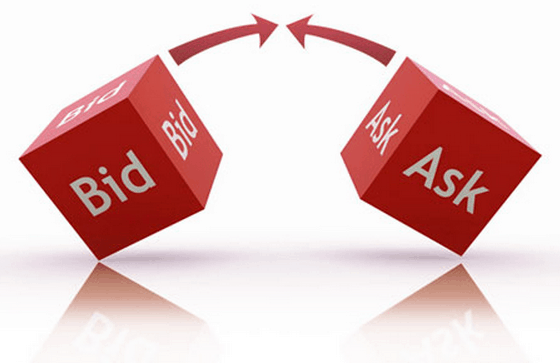What is the spread in trading?
When you trade, the spread is an important factor you need to account for. The spread forms the transaction fee of a trade and can be seen as the difference between the buy- and sell price. But what is the spread in trading?
What are the buy- and sell price?
 When investing, there is always a bid and an asking price. But what do these prices indicate?
When investing, there is always a bid and an asking price. But what do these prices indicate?
- The bid price is the price at which you can sell the share.
- The asking price is the price at which you can buy the share
What is the bid price?
The buy or bid price is the price that the broker is willing to pay for the stock. The buy price or ‘bid’ is always lower than the sell price or ‘ask’. With some brokers you can place an order on a falling price as well. When you do this you achieve a positive result if the stock price decreases. Speculation on a falling stock price is called shorting.
What is the ask price?
The asking price indicates at what amount you can buy a share. When you buy a share you earn money when the price increases.
What is the spread?
The offer and asking price together constitute the quote. Within the quote there is always a difference between the offer and asking price. This difference represents the cost to you as an investor, and we call it the spread.
By determining the difference between the bid and asking price you will find the spread or cost per unit. You can then multiply this amount by the number of shares to find out how much you pay in total.
Why should you consider the spread?
When you sometimes buy or sell a share, the spread is not very important. After all, you only pay the small amount once. However, the spread is important for the active day trader. As a trader, you perform multiple trades within a short time frame. On every transaction you will have to pay the spread.
It is therefore wise to take a good look at which broker you can trade with cost-effectively. We’ve researched the best brokers for cost-effective investing. Use the button below to compare them:
How is the spread calculated?
The spread is a result of supply and demand within the market. Buyers want to buy shares as cheaply as possible while sellers prefer to sell shares at the highest possible price. When the price of a share is at $10, the seller can choose to sell the share for $10.02. When you take the offer, you are paying 2 cents worth of spread.
Brokers increase the spread by charging transaction fees.
What affects the spread?
The size of the spread may vary. When the bid price and asking price are close together, there is a tight market. The buyers and sellers then agree on the price of a share. In a large market, the opposite is happening: buyers and sellers cannot agree on a price.
The following factors affect the size of the spread:
- Liquidity: liquidity indicates how easy it is to buy or sell a share. When liquidity is high, the spread decreases.
- Volume: when the volume is high, there is a lot of trading activity. When the volume of trading increases, the size of the spread usually decreases.
- Volatility: volatility is a measure of risk in a given security or market index. With higher volatility, the spread usually increases.
What does spread look like?
You can see the spread by looking at the difference between the buy and the sale price. Below is an example of spread on a CFD at Plus500:
![]()
What is the difference between a dynamic and a variable spread?
A dynamic or variable spread is a spread that can change sporadically. When you start investing in a security with a dynamic spread, it’s important to make sure that the spread hasn’t become too unpredictable.
A fixed spread doesn’t change. With some brokers, you will agree on a fixed spread on certain securities. Also, when investing, you sometimes have to pay a fixed commission on your investment.
When can the spread increase?
The spread can increase if a given share’s trading activity drops. Also, during strong market movements, you may have to pay a higher spread. When many people want to sell a share, the spread can increase considerably.
How is the spread calculated when trading Forex?
On the EUR/USD currency pair the spread is usually 0.0002 per unit or less. Currencies are traded in whole units (1 euro, 1 dollar, 1 Yen, etc.) and the costs are calculated by multiplying the amount of the currencies you trade by the spread.
When you open a position of $10,000, you pay 0.0002 (cost per unit) x 10,000 = $2 in fees.
The spread in pips
Most brokers display the spread in pips. One pip is the fourth decimal of a currency pair, or 0.0001. Only the Japanese Yen is the exception to this rule, there the pip is the second decimal, or 0.01. If, instead of Forex, you trade stocks, commodities or index funds, the transaction fees are mostly displayed as fixed fees.
Why is there a spread?
A spread arises through the interplay of supply and demand. The quote or price of a share is created by combining the different buy and sell orders of the parties involved. This creates a market. The broker often increases the price to make money from the executed trades. This increases the spread further.
Auteur

Over Alex Mostert
When I was 16, I secretly bought my first stock. Since that ‘proud moment’ I have been managing trading.info for over 10 years. It is my goal to educate people about financial freedom. After my studies business administration and psychology, I decided to put all my time in developing this website. Since I love to travel, I work from all over the world. Click here to read more about trading.info! Don’t hesitate to leave a comment under this article.
